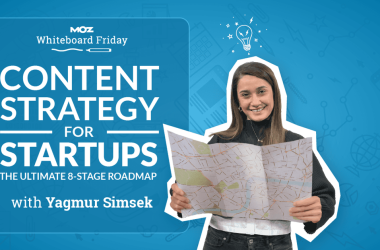It can be tempting to jump right into creating content without a concrete campaign plan or long-term content strategy in place. But spending the time (and resources) to set goals and decide what you want to publish can help you better meet your customers’ needs and reach your business goals or KPIs.
A content strategy typically spans the entire content marketing funnel, from awareness to decision and possibly through customer success. You may have somebody on your marketing team or within your organization who specifically focuses on the strategy part of content marketing. Or, if you work for a smaller organization, you may focus on both strategy and execution.
Key Initiatives in Building a Content Strategy
Whether you work in B2B or B2C marketing—creating a content strategy is crucial to your success. It’s important you prioritize these six key initiatives along the way.
1. Define your goals
As you build your content strategy, make sure you first identify your goals. Are you looking to drive brand awareness? Generate leads? Drive sales? Create consumer loyalty? All of the above? Make this clear from the get-go.
Whether for a specific campaign or an overarching content plan, your strategy will likely span the entire marketing funnel. But this may vary depending on your business objectives, the size and structure of your organization, and other factors.
Define the specific benchmarks and KPIs you hope to achieve when you create content. To help define those goals, consider the following metrics:
- For top-of-funnel (brand awareness) content: Social media engagement, blog and/or web traffic, content downloads, newsletter open rate, average time-on-page, organic search rankings, etc.
- For mid-funnel (consideration) content: Marketing qualified leads (MQLs), form submissions for eBooks, newsletter click-through rates, demos scheduled from UTM links in content, click-through rates on PPC ads, etc.
- For bottom-of-funnel (decision) content: Sales qualified leads (SQLs), deals closed, revenue generated, meetings scheduled via chatbot, etc.
- For post-sale (customer success/retention) content: Repeat customers, brand sentiment/affinity, repeat purchases, cross-sell or upsell purchases, brand advocacy, etc.
2. Analyze data to drive your strategy
Before you create content, you need to know your audience and the best ways to reach them effectively. You can leverage both qualitative and quantitative data when researching your target audience. Quantitative data can be gathered from surveys and other data sources, while qualitative data is often gathered through interviews with your target audience. The latter can help you understand the “why” behind the quantitative data.
You might also consider collecting primary data (gathered firsthand) as well as secondary information published by other credible sources. Both are useful in their own ways. Helpful data to collect might include:
- Demographics, habits, and preferences
- Publications your audience consumes regularly
- Biggest obstacles they encounter when making a purchase
- Solutions to problems they commonly face
- Topics of interest they want to know more about
- What will help them do their job better
Conduct a competitive analysis to learn even more about your audience. You can leverage tools such as Google Search Console and Semrush to understand what your target audience is searching for on Google and identify content angles your competitors haven’t yet published. Relevant tools, like BuzzSumo, for your MarTech stack may also be helpful.
3. Build seamless customer experiences
If you leverage multiple content channels in your strategy, your message should be consistent across all of them. This is the purpose of integrated marketing communications and good storytelling in the first place!
Think of every piece of content along your customer journey as a chapter in a larger story.
Meet your customer where they are, and remember that a prospect or customer may find the information they need in a variety of places—especially in B2B marketing, where the buyer journey can last months or even years.
Also, try to direct your audience seamlessly from one piece of content to another. This may entail driving to a long-form eBook or a landing page from a blog post, for example, or hyperlinking to data sources within an article. Think holistically and avoid publishing one-off pieces that steer your reader toward a dead end.
Building a seamless customer experience also means avoiding redundancy. Don’t, for example, target existing customers with an ad meant to generate leads. This may require more collaboration across your organization—such as between a content marketing manager and a paid media specialist.
4. Define your content channels, workflows, and timeline
Part of creating content that drives ROI means knowing what channels to leverage at each stage of the funnel for each target audience. Your research can help you know which content formats will best resonate with your audience at the right time. Some examples:
- For brand awareness (top-of-funnel): Educational blogs, social media, newsletters, videos, podcasts
- For consideration (mid-funnel): eBooks, white papers, infographics, landing pages, webinars, events, nurture emails, product-focused blogs, case studies
- For decision (sale): Sales decks, product demos, competitive battle cards, product fact sheets, email sales sequences
- For customer success (post-sale): Membership or loyalty program registrations, video tutorials, product feature tours, use case guides, eBooks
Creating a rough calendar of what content you plan to publish and when can help you stay organized as you assign work to writers and build editorial workflows. For your overarching content strategy or a year-long marketing campaign, you might create a simple calendar showing what channels or themes you’ve prioritized each month or quarter.
5. Measure your content performance.
Tracking your user journey and success at each stage can help you determine your content marketing ROI and better meet your customer’s needs moving forward. This means regularly evaluating success so you can adapt your strategy accordingly and gather information to drive a strategy.
Performance goes beyond solely attributing content to revenue. It doesn’t really make sense to try and drive sales before you determine how effectively you build an audience or generate leads. According to Gartner, only 17% of B2B buyers’ time is spent meeting with sales reps—but they spend more than a quarter of their time conducting research online. This is where content comes into play.
6. Revisit your content strategy as needed
On that note, building a content strategy isn’t always a one-and-done project. The data you collect in Step 5 can inform long-term or campaign-specific content ideas. Plus, you can optimize content that’s performing particularly well (and spend less time optimizing content that isn’t).
External factors, like the pandemic or organizational layoffs, may also require you to adjust your strategy. Consider scheduling a recurring meeting with your team and relevant stakeholders where you revisit your long-term content strategy or make tweaks as you carry out marketing campaigns.
If you need help building your content strategy, Contently offers advanced audience insights, competitive analysis, and SEO-driven ideation.
Sign up for our live monthly demo to better understand Contently can help you create a strategy that drives ROI.
The post 6 Key Initiatives That Will Make Your Content Strategy Shine appeared first on Contently.





